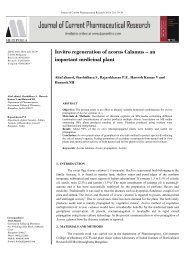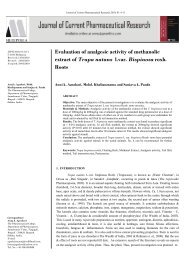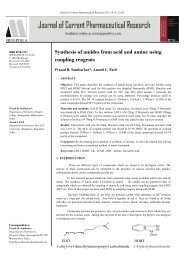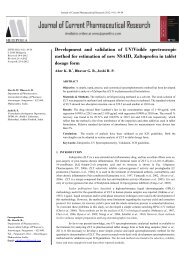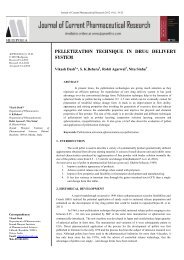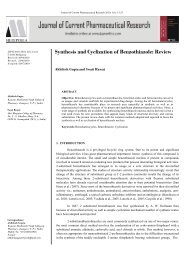Preparation and Evaluation of Fast Dissolving Tablets of Celecoxib
Preparation and Evaluation of Fast Dissolving Tablets of Celecoxib
Preparation and Evaluation of Fast Dissolving Tablets of Celecoxib
Create successful ePaper yourself
Turn your PDF publications into a flip-book with our unique Google optimized e-Paper software.
Journal <strong>of</strong> Current Pharmaceutical Research 04 (2010) 4-11<br />
JCPR 2010, 04: 4-11<br />
© 2010 Medipoeia<br />
Received: 11-12-2010<br />
Revised: 15-12-2010<br />
Accepted: 22-12-2010<br />
<strong>Preparation</strong> <strong>and</strong> <strong>Evaluation</strong> <strong>of</strong> <strong>Fast</strong> <strong>Dissolving</strong><br />
<strong>Tablets</strong> <strong>of</strong> <strong>Celecoxib</strong><br />
Vijay Tiwari*, Dhana jay kinikar, Krishna Pillai, <strong>and</strong> P.D.Gokulan<br />
Vijay Tiwari, Dhana jay kinikar,<br />
Krishna Pillai, <strong>and</strong> P.D.Gokulan<br />
Department <strong>of</strong> Medicinal Chemistry,<br />
Shri Ramnath singh Institute Of<br />
Pharmaceutical science & technology 1 ,<br />
ABSTRACT<br />
Objective: The purpose <strong>of</strong> this research was to study fast dissolving tablets <strong>of</strong> <strong>Celecoxib</strong> using<br />
solid dispersion <strong>of</strong> <strong>Celecoxib</strong> <strong>and</strong> sorbitol by holt melt extrusion process, <strong>and</strong> superdisintegrants<br />
(sodium starch glycolate), binder (polyvinylpyrrolidone), sweetner (saccharine sodium), flavour<br />
(menthol).<br />
Material <strong>and</strong> methods: Six different formulation <strong>of</strong> solid dispersion is prepared <strong>and</strong> the batch<br />
having the best drug release pr<strong>of</strong>ile is used for the preparation <strong>of</strong> nine batches <strong>of</strong> fast dissolving<br />
tablets by direct compression method. The tablet is characterized by hardness, wetting time,<br />
weight variation, in-vitro drug dissolution, <strong>and</strong> in-vivo taste evaluation.<br />
Results: All batches <strong>of</strong> solid dispersion <strong>and</strong> fast dissolving tablets are satisfactory in terms <strong>of</strong><br />
dissolution pr<strong>of</strong>ile. The hardness, wetting time, drug content analysis <strong>and</strong> taste evaluation <strong>of</strong><br />
tablets are also shows the satisfactory result. The batch <strong>of</strong> solid dispersion containing maximum<br />
concentration <strong>of</strong> sorbitol polymer is showing best drug release. In fast dissolving tablets the<br />
batch containing maximum concentration <strong>of</strong> superdisintegrant is showing the best drug release.<br />
Conclusion: The FDT6 batch <strong>of</strong> fast dissolving tablets is shows the 99.74 % cumulative drug<br />
release in 30 min. The FDT6 is best in all nine formulations <strong>of</strong> fast dissolving tablets <strong>of</strong><br />
<strong>Celecoxib</strong>. So the bioavailability <strong>of</strong> <strong>Celecoxib</strong> is increased by fast dissolving dosage form.<br />
Keywords: <strong>Celecoxib</strong>, Solid dispersion, <strong>Fast</strong> dissolving tablet, sorbitol<br />
1. INTRODUCTION<br />
Correspondence:<br />
Vijay Tiwari<br />
Department <strong>of</strong> Medicinal Chemistry,<br />
Sri Ram Nath Singh Institute Of<br />
Pharmaceutical science & technology,<br />
Sitholi,Gwalior India.<br />
email: gokulakila@yahoo.co.in<br />
<strong>Fast</strong> dissolving tablets are best alternate to deliver the drug having bitter taste <strong>and</strong> poor<br />
oral bioavailability. <strong>Celecoxib</strong> (CXB) is a non-steroidal antiinflamatory drug (NSAIDS), acting by<br />
inhibition <strong>of</strong> prostagl<strong>and</strong>ins, by inhibiting the activity <strong>of</strong> the enzyme cyclooxygenase-2 (COX-2).<br />
It is selective <strong>and</strong> non-competitive for COX 2 inhibitor. <strong>Celecoxib</strong> is preferred over conventional<br />
NSAIDs, as the latter may lead to serious gastrointestinal complications such as ulcer, severe<br />
bleeding <strong>and</strong> perforation, resulting in hospitalization, <strong>and</strong> even death. It is mainly used for the<br />
osteoarthritis, rheumatoid arthritis, <strong>and</strong> dysmenorrhea. The drug is available in tablet form, <strong>and</strong> is<br />
yet not <strong>of</strong>ficial in any Pharmacopoeia. <strong>Celecoxib</strong> is practically insoluble in water resulting in<br />
absorption problem. It is well absorbed in the gastrointestinal tract. When taken with a high fat<br />
meal, peak plasma levels are delayed for about 1 to 2 hours with an increase in total absorption<br />
(AUC) <strong>of</strong> 10% to 20%(http://www.drugbank.ca/drugs/DB00482). The rate <strong>and</strong> extent <strong>of</strong><br />
dissolution <strong>of</strong> the drug from any solid dosage form, determines the rate <strong>and</strong> extent <strong>of</strong> absorption <strong>of</strong><br />
the drug. In the case <strong>of</strong> poorly water- soluble drugs, dissolution is the rate-limiting step in the<br />
process <strong>of</strong> drug absorption. Potential bioavailability problems are prevalent with extremely<br />
hydrophobic drugs (aqueous solubility less than 3.3 mg/ml at 37°)<br />
(http://www.rxlist.com/celebrex-drug.htm), due to erratic or incomplete absorption from GIT. The<br />
solid dispersion approach has been widely <strong>and</strong> successfully applied to improve the dissolution,<br />
solubility, <strong>and</strong> consequently the bioavailability <strong>of</strong> poorly water-soluble drugs. A number <strong>of</strong> drugs<br />
have been shown to improve their dissolution character, when converted to solid dispersions.
Journal <strong>of</strong> Current Pharmaceutical Research 04 (2010) 4-11<br />
To date, some reports on the formulation <strong>of</strong> these systems<br />
have appeared. Because <strong>of</strong> its poor aqueous solubility, <strong>Celecoxib</strong><br />
may pose dissolution related absorption problem. Hence, an<br />
attempt was made to improve the dissolution <strong>of</strong> CXB by preparing<br />
its solid dispersion <strong>and</strong> finally into fast dissolving tablets using<br />
sodium starch glycolate as superdisintgrants.<br />
2. MATERIALS AND METHODS<br />
Material<br />
<strong>Celecoxib</strong> drug was procured from Exim Pharma<br />
international, Mumbai. The sorbitol is used for the preparation <strong>of</strong><br />
solid dispersion. Sodium starch glycolat was provided by Vjalak<br />
Pharma LTD., Hyderabad. Magnessium sterate <strong>and</strong> Saccharin<br />
sodium was procured from Central Drug House, New Delhi,<br />
Sorbitol, PVP <strong>and</strong> Quinine sulphate was purchased from R.K.<br />
Chemical distributors, Meerut. Menthol was procured from Bhagat<br />
Aromatics Limited, India.<br />
3. EXPERIMENTAL<br />
3. 1 <strong>Preparation</strong> <strong>of</strong> solid dispersion<br />
Solid dispersion <strong>of</strong> <strong>Celecoxib</strong> was prepared with sorbitol<br />
polymer with various drug-polymer ratios (1:1, 1:2, 1:4, 1:6, 1:8,<br />
1:10). Hot melt extrusion method was used to prepare the solid<br />
dispersion. Hot melt extrusion approach represent the<br />
advantageous mean <strong>of</strong> preparation <strong>of</strong> solid dispersion by using the<br />
twin screw hot melt extruder where only thermostable components<br />
are relevant. The extruder consists <strong>of</strong> a hopper, barrel, a die, a<br />
kneading screw <strong>and</strong> heaters. The physical mixture is introduced<br />
into the hopper that is forwarded by feed screw <strong>and</strong> finally is<br />
extruded from the die. Melt extrusion is essentially the same as the<br />
fusion method except that intense mixing <strong>of</strong> the components is<br />
induced by the extruder. When compared to melting in a vessel, the<br />
product stability <strong>and</strong> dissolution are similar, but melt extrusion<br />
<strong>of</strong>fers the potential to shape the heated drug-matrix mixture into<br />
implants, ophthalmic inserts, or oral dosage forms (Patidar K et al.,<br />
2010).<br />
Table 1 Various formulations <strong>of</strong> solid dispersion with varying<br />
drug-polymer ratio<br />
Formulations<br />
Drug : Polymer<br />
SD 1 1 : 1<br />
SD 2 1 : 2<br />
SD 3 1 : 4<br />
SD 4 1 :6<br />
SD 5 1 : 8<br />
SD 6 1 : 10<br />
3.2 <strong>Evaluation</strong> <strong>and</strong> selection <strong>of</strong> solid dispersion<br />
All six batches <strong>of</strong> solid dispersion were evaluated for their<br />
drug content uniformity <strong>and</strong> dissolution pr<strong>of</strong>ile to select the<br />
optimized batch. Batch SD6 showed best dissolution pr<strong>of</strong>ile <strong>and</strong><br />
was selected for the preparation <strong>of</strong> fast dissolving tablets.<br />
3.3 Drug content analysis<br />
Drug content was determined by dissolving the 100 mg <strong>of</strong><br />
solid dispersion into 100 ml buffer having pH 1.2. Allow to st<strong>and</strong><br />
the samples for one night. Then filter the solution <strong>and</strong> measure the<br />
absorbance on UV-spectrophotometer at suitable wavelength (252<br />
nm). The experiment was conducted in triplicate. Dilution was<br />
performed if required necessary.<br />
3.4 In-vitro dissolution study <strong>and</strong> selection <strong>of</strong> best blend to<br />
prepare FDT<br />
In-vitro dissolution study for all six batches <strong>of</strong> solid<br />
dispersion was performed in USP Dissolution Apparatus II paddle<br />
type <strong>and</strong> batch having best drug release pr<strong>of</strong>ile is selected for the<br />
preparation <strong>of</strong> fast dissolution tablets.<br />
3.5 Formulation <strong>of</strong> tablets <strong>of</strong> celecoxib-sorbitol solid dispersion<br />
(Batch SD6 Formula)<br />
The fast dissolving tablets are prepared by direct<br />
compression method. It is the easiest way to manufacture tablets.<br />
Conventional equipment, commonly available excipients <strong>and</strong> a<br />
limited number <strong>of</strong> processing steps are involved in direct<br />
compression. Also high doses can be accommodated <strong>and</strong> final<br />
weight <strong>of</strong> tablet can easily exceed that <strong>of</strong> other production methods<br />
(Bhowmik D et al., 2009).<br />
3.6 <strong>Evaluation</strong> <strong>of</strong> powdered blend<br />
Powdered blends were evaluated for following bulk<br />
properties.<br />
Bulk characterization<br />
3.6.1 Bulk density<br />
Density is defined as weight per unit volume. Bulk<br />
density is defined as the mass <strong>of</strong> the powder divided by the bulk<br />
volume.<br />
Apparent bulk density was determined by pouring pre- sieved drug<br />
excipient blend into a graduated cylinder <strong>and</strong> measuring the<br />
volume <strong>and</strong> weight “as it is”. It is expressed in g/cm 3 <strong>and</strong> is given<br />
by<br />
D b = M / V 0<br />
Where, M is the mass <strong>of</strong> powder <strong>and</strong> V 0 is the Bulk volume <strong>of</strong> the<br />
powder.<br />
3.6.2 Bulkiness<br />
Specific bulk volume or reciprocal <strong>of</strong> bulk density is<br />
called bulkiness or bulk. Bulkiness increases with a decrease in
Journal <strong>of</strong> Current Pharmaceutical Research 04 (2010) 4-11<br />
Table 2 Various formulations with varying concentration <strong>of</strong> excipient (superdisintegrants <strong>and</strong> binder)<br />
S.No. FDT 1 FDT 2 FDT 3 FDT 4 FDT 5 FDT 6 FDT 7 FDT 8 FDT 9<br />
Ratio <strong>of</strong> A vs B 1:1 1:2 1:3 1:4 1:5 5:1 4:1 3:1 2:1<br />
Solid dispersion (mg) 550 550 550 550 550 550 550 550 550<br />
Sodium starch glycolate (Superdisintegrant) (A) 10 6.66 5 4 3.33 16.6 16 15 13.3<br />
Poly vinyl pyrolidone (Binder) (B) 10 13.3 15 16 16.6 3.33 4 5 6.66<br />
Saccharin sodium (Sweetener) 2 2 2 2 2 2 2 2 2<br />
Magnesium sterate (Glidant) 1 1 1 1 1 1 1 1 1<br />
Flavour 1 1 1 1 1 1 1 1 1<br />
particle size. In mixture <strong>of</strong> material <strong>of</strong> different sizes, however the<br />
smaller particle shifts between the larger particles <strong>and</strong> tends to<br />
reduce the bulkiness. The bulkiness can be calculated by the<br />
following formula<br />
Bulkiness= I/ D b<br />
where, D b = Bulk Density.<br />
3.6.3 Drug content uniformity<br />
Drug content was determined by dissolving the 100 mg <strong>of</strong><br />
bulk powder into 100 ml distilled water. Allow to st<strong>and</strong> the<br />
samples for one night. Then filter the solution <strong>and</strong> measure the<br />
absorbance on UV-spectrophotometer at suitable wavelength (252<br />
nm). The experiment was conducted in triplicate. Dilution was<br />
performed if required necessary.<br />
3.6.4 Tapped density<br />
It was determined by placing a graduated cylinder,<br />
containing a known mass <strong>of</strong> drug excipient blend, on mechanical<br />
tapping apparatus. The tapped volume was measured by tapping<br />
the powder to constant volume. It is expressed in g/ml <strong>and</strong> is given<br />
by<br />
Dt = M / Vt Where, M is the mass <strong>of</strong> powder <strong>and</strong> Vt is the tapped<br />
volume <strong>of</strong> the powder.<br />
3.6.5 Void volume<br />
The volume <strong>of</strong> the spaces is known as the void volume “v” <strong>and</strong> is<br />
given by the Formula:<br />
V=V b -V p<br />
Where, Vb = Bulk volume (volume before tapping)<br />
V = True volume (volume after tapping)<br />
3.6.6 Angle <strong>of</strong> repose<br />
Angle <strong>of</strong> repose is used for the measurement <strong>of</strong> frictional<br />
force in a loose powder. Angle <strong>of</strong> repose was determined by using<br />
funnel method suggested by Newman. Powder was poured from a<br />
funnel that can be raised vertically until a maximum cone height, h,<br />
was obtained. Diameter <strong>of</strong> heap, D, was measured. The angle <strong>of</strong><br />
repose, Ө, was calculated by formula tan Ө = h / r, Ө = tan-1 (h / r)<br />
Where, Ө is the angle <strong>of</strong> repose, h is the height in cm <strong>and</strong> r is the<br />
radius.<br />
Angle <strong>of</strong> repose less than 30 0 shows the free flowing <strong>of</strong> the<br />
material.<br />
3.6.7 Carr’s index<br />
It is expressed in percentage <strong>and</strong> is expressed by<br />
I = D t – D b / D t<br />
Where, D t is the tapped density <strong>of</strong> the powder<br />
Db is the bulk density <strong>of</strong> the powder.<br />
3.6.8 Hausner ratio<br />
It is expressed in percentage <strong>and</strong> is expressed by<br />
H= D t / D b<br />
Where, D t is the tapped density <strong>of</strong> the powder<br />
D b is the bulk density <strong>of</strong> the powder.<br />
3.6.9 Percent porosity<br />
The porosity € <strong>of</strong> powder is defined as the ratio <strong>of</strong> void<br />
volume to the bulk volume <strong>of</strong> the packaging. The porosity <strong>of</strong> the<br />
powder is given by €= V b – V p / V p =1- V p /V b<br />
Porosity is frequently expressed in percentage <strong>and</strong> is given as %€ =<br />
(1 – V p / V b ) X 100
Journal <strong>of</strong> Current Pharmaceutical Research 04 (2010) 4-11<br />
3.6.10 Percent Compressibility<br />
It is an important measure obtained from bulk density <strong>and</strong><br />
is defined as,<br />
C=D b -D u /D b x100<br />
Where, D b is bulk density <strong>of</strong> the powder <strong>and</strong> D u is loose bulk<br />
density.<br />
If the bed <strong>of</strong> particles is more compressible the blend will be less<br />
flowable <strong>and</strong> flowing materials.<br />
3.7 Compression <strong>of</strong> various powdered blends<br />
The various powder blends were compressed with a<br />
rotatory tablet press machine (Cad Mack). Every formulation<br />
tablets 574 mg in weight were prepared by using 12 mm round, flat<br />
faced punches. For the preparation <strong>of</strong> tablets, the fill volume <strong>of</strong> the<br />
die was adjusted to corresponding 574 mg weight. Then the tablets<br />
were compressed one by one, with compression force <strong>of</strong> 24 kg.<br />
3.8 <strong>Evaluation</strong> <strong>of</strong> tablets <strong>of</strong> celeecoxib-sorbitol dispersion SD6:<br />
3.8.1 Appearance, size, shape, thickness <strong>and</strong> diameter <strong>of</strong> tablet<br />
The size <strong>and</strong> shape <strong>of</strong> the tablet can be dimensionally<br />
described, monitored <strong>and</strong> controlled. Thickness <strong>of</strong> tablets is an<br />
important characteristic for appearance <strong>and</strong> also in counting by<br />
using filling equipment. Some filling equipment utilizes the<br />
uniform thickness <strong>of</strong> the tablets as a counting mechanism. Ten<br />
tablets were taken <strong>and</strong> their thickness <strong>and</strong> diameter were measured<br />
by electronic screw gage.<br />
3.8.2 Weight variation<br />
Indian Pharmacopoeia procedure for uniformity <strong>of</strong> weight<br />
was followed, twenty tablets were taken <strong>and</strong> their weight was<br />
determined individually <strong>and</strong> collectively on a digital weighing<br />
balance. The average weight <strong>of</strong> one tablet was determined from the<br />
collective weight. The weight variation test would be a satisfactory<br />
method to determining the drug content uniformity.<br />
3.8.3 Friability<br />
Friabillator consist <strong>of</strong> a plastic-chamber that revolves at<br />
25 rpm, dropping those tablets at a distance <strong>of</strong> 6 inches with each<br />
revolution. The tablets were rotated in the friabillator for at least 4<br />
minutes. At the end <strong>of</strong> test tablets were dusied <strong>and</strong> reweighed, the<br />
loss in the weight <strong>of</strong> tablet is the measure <strong>of</strong> friability <strong>and</strong> is<br />
expressed in percentage as (Jain CP et al., 2009):<br />
%Friability = initial weight- final weight/initial weight x 100<br />
3.8.4 Hardness<br />
Hardness <strong>of</strong> tablet is defined as the force applied across<br />
the diameter <strong>of</strong> the tablet in the order to break the tablet. The<br />
resistance <strong>of</strong> the tablet to abrasion or breakage under condition <strong>of</strong><br />
storage transformation <strong>and</strong> h<strong>and</strong>ling before usage depends on its<br />
hardness. Hardness <strong>of</strong> the tablet <strong>of</strong> each formulation was<br />
determined using Pfizer Hardness tester (Jain CP et al., 2009).<br />
3.8.5 Drug content uniformity<br />
Six tablets were placed in 100 ml volumetric flask<br />
individually. Volume was made up 100 ml by adding distilled<br />
water. After one night filter the sample <strong>and</strong> measure the<br />
absorbance on UV spectrophotometry at 252 nm. Dilute the<br />
solution if necessary (Shinde AKJ et al., 2010).<br />
Table 3 Drug content <strong>of</strong> various blends <strong>of</strong> solid dispersion<br />
3.8.6 Wetting time<br />
Formulation<br />
In this method tablet wetting time was measured. Simple<br />
tissue paper (12 cm X 10.75 cm) folded twice was placed in a<br />
small Petri dish (Internal Diameter = 6.5 cm) containing 6 ml <strong>of</strong><br />
Sorenson’s buffer pH 6.8. A tablet was put on the paper, <strong>and</strong> the<br />
time for complete wetting was measured. Three trials for each<br />
batch <strong>and</strong> the st<strong>and</strong>ard deviation were also determined (Shinde<br />
AKJ et al., 2010).<br />
3.8.7 In-vitro disintegration time<br />
In vitro disintegration time was measured by dropping a<br />
tablet in a beaker containing 50 ml <strong>of</strong> Sorenson’s buffer pH 6.8.<br />
Three tablets from each formulation were r<strong>and</strong>omly selected <strong>and</strong> in<br />
vitro disintegration time was performed.<br />
3.8.8 In-vivo disintegration time<br />
Drug Content (mg)<br />
SD 1 0.53 ± 0.2<br />
SD 2 0.25 ± 0.1<br />
SD 3 0.178 ± 0.3<br />
SD 4 0.133 ±0.1<br />
SD 5 0.106 ± 0.2<br />
SD 6 0.09 ± 0.2<br />
The test was carried out in 3 tablets observed individually<br />
by placing in mouth <strong>and</strong> the time in second taken for complete
Journal <strong>of</strong> Current Pharmaceutical Research 04 (2010) 4-11<br />
disintegration <strong>of</strong> the tablet.<br />
3.8.9 Modified disintegration time<br />
Bi et al. suggested the use <strong>of</strong> a modified dissolution<br />
apparatus, instead <strong>of</strong> the disintegration apparatus. In this<br />
experiment, 900 ml <strong>of</strong> water maintained at 37 °C as the<br />
disintegration fluid <strong>and</strong> a paddle at 100 rpm as stirring element<br />
were used. Disintegration time was noted when the tablet<br />
disintegrated <strong>and</strong> passed completely through the screen <strong>of</strong> the<br />
sinker (3–3.5) mm in height <strong>and</strong> 3.5–4 mm in width, immersed at a<br />
depth <strong>of</strong> 8.5 cm from the top with the help <strong>of</strong> a hook). This method<br />
was useful in providing discrimination among batches which was<br />
not possible with the conventional disintegration apparatus (Indian<br />
Pharmacopoeias 1996).<br />
Table 4 Dissolution data <strong>of</strong> various solid dispersion <strong>of</strong> <strong>Celecoxib</strong>.<br />
Time<br />
(Min) SD 1 SD 2 SD 3 SD 4 SD 5 SD 6<br />
1 2.2 3 5 5 7 8<br />
5 8 9.9 11 11.8 12 14.1<br />
10 13.2 15.8 17.3 18.2 19.5 20.8<br />
15 16.89 20.8 23 25.2 28.4 32<br />
30 23 31 37 42 49 54<br />
45 49.79 47 52 57 64 66<br />
60 89 92 95 97 96 99<br />
RESULTS AND DISCUSSION<br />
Figure 1 % cumulative drug release <strong>of</strong> pure drug <strong>and</strong> blends <strong>of</strong><br />
solid <strong>of</strong> solid dispersion<br />
The six batches <strong>of</strong> solid dispersions (SD1, SD2, SD3,<br />
SD4, SD5, SD6) <strong>of</strong> <strong>Celecoxib</strong> <strong>and</strong> sorbitol are prepared. The<br />
cumulative percentage drug release <strong>of</strong> SD1, SD2, SD3, SD4 SD5,<br />
SD6 batches in 60 min are 89, 92, 95, 97, 96, 99 respectively<br />
enlisted in Table 4. The SD6 batch show the best drug release<br />
pr<strong>of</strong>ile (% cumulative drug release in 60min is 99%). So SD6 batch<br />
is used for the preparation <strong>of</strong> fast dissolving tablets. Nine batches<br />
<strong>of</strong> fast dissolving tablets (FDT1, FDT2, FDT3, FDT4, FDT5,<br />
FDT6, FDT7, FDT8, <strong>and</strong> FDT9) were prepared <strong>and</strong> their formulas<br />
are enlisted in Table 2. The cumulative percentage drug release in<br />
30 min <strong>of</strong> FDT1, FDT2, FDT3, FDT4, FDT5, FDT6, FDT7, FDT8,<br />
FDT9 batches is 98.74, 97.14, 97.59, 97.16, 96.34, 99.74, 97.84,<br />
97.14, 97.14 respectively. The FDT6 batch shows the best drug<br />
release pr<strong>of</strong>ile.<br />
CONCLUSION<br />
Figure 2 In-vitro drug release <strong>of</strong> tablet formulations<br />
3.8.10 In-vitro dissolution study <strong>of</strong> tablets<br />
In-vitro drug release pr<strong>of</strong>ile <strong>of</strong> the formulations <strong>of</strong> fast<br />
dissolving tablets were determined by USP Dissolution Apparatus<br />
II paddle type, using 1.2 pH simulated gastric fluid using 900 ml at<br />
37 o C. The paddle was rotated at 50 rpm for 60 min (Patel MM et<br />
al., 2006).<br />
<strong>Fast</strong> dissolving tablets dosage form proves its significance<br />
for enhancing the bioavailability <strong>of</strong> water insoluble drug by<br />
increasing its dissolution <strong>and</strong> solubility. The inclusion <strong>of</strong> solid<br />
dispersion process as a step <strong>of</strong> preparation <strong>of</strong> fast dissolving tablets<br />
have a synergistic effect on the bioavailability <strong>of</strong> final dosage form<br />
by its contribution in improvement in solubility pr<strong>of</strong>ile.<br />
The solid dispersion batch SD6 having drug polymer ratio 1:10<br />
showed best % cumulative drug release 99% with in 60 min among<br />
the six batches.<br />
The FDT6 batch <strong>of</strong> fast dissolving tablets showed best %<br />
cumulative drug release 99.74% with in 60 min among all nine<br />
batches <strong>of</strong> fast dissolving tablets. FDT6 have the highest<br />
proportion <strong>of</strong> superdisintegrant (sodium starch glycolate) in all the<br />
formulation. It is observed that wetting time (10±2.65) <strong>and</strong><br />
disintegration time (USP method-24, modified method-49) <strong>of</strong><br />
FDT6 batch was minimum in comparison to other batches <strong>of</strong> fast<br />
dissolving tablets. So it proves that the concentration <strong>of</strong>
Journal <strong>of</strong> Current Pharmaceutical Research 04 (2010) 4-11<br />
Table 5 Micromeritic evaluation property <strong>of</strong> bulk powder blends<br />
Micromeritic<br />
Property<br />
FDT<br />
1:1<br />
FDT<br />
1:2<br />
FDT<br />
1:3<br />
FDT<br />
1:4<br />
FDT<br />
1:5<br />
FDT<br />
5:1<br />
FDT<br />
4:1<br />
FDT<br />
3:1<br />
FDT<br />
2:1<br />
Angle <strong>of</strong> repose (θ) 27.45 27.21 26.23 25.67 24.42 30.57 30.01 28.97 28.34<br />
Bulk Density (g/cm 3 ) 0.47 0.44 0.41 0.42 0.38 0.43 0.41 0.44 0.38<br />
Bulkiness 2.27 2.32 2.51 2.50 2.56 2.21 2.24 2.51 2.52<br />
Tapped density (g/cm 3 ) 0.632 0.29 0.617 0.71 0.611 0.72 0.69 0.68 0.623<br />
Void volume (ml) 1.3 0.8 0.7 1.4 1.1 1.4 0.9 0.7 1.8<br />
Carr’s index (%) 11 11 11 10 12 12 13 12 13<br />
Hausner’s Ratio(%) 1.48 1.53 1.51 1.54 1.58 1.51 1.53 1.54 1.51<br />
Porosity (%) 12.12 13.08 15.07 19.41 10.7 11.17 12.16 12.11 16.04<br />
Compressibility (%) 16.44 14.11 12.16 11.22 12.19 16.12 10.24 13.24 14.52<br />
Table 6 Drug content <strong>of</strong> various FDT formulations<br />
S.No. Batch Average Concentration (mg)<br />
1 F1 49.82±0.23<br />
2 F2 49.78±0.34<br />
3 F3 49.65±0.45<br />
4 F4 50.07±0.15<br />
5 F5 49.92±0.36<br />
6 F6 49.98±0.47<br />
7 F7 49.74±0.41<br />
8 F8 49.89±0.32<br />
9 F9 49.87±0.22<br />
Table 7 Percentage cumulative drug released data <strong>of</strong> formulations (F1-F5)<br />
S.No. Time (min.)<br />
Cumulative percentage drug release (mean±sd) (n=3)<br />
FDT1 FDT2 FDT3 FDT4 FDT5<br />
1 1 15.98 14.43 14..95 15.43 15.23<br />
2 5 28.95 26.96 27.42 28.97 29.37<br />
3 10 45.69 44.69 43.01 45.34 46.33<br />
4 15 73.57 74.41 74.69 73.46 72.37<br />
5 20 85.95 88.95 85.43 85.82 85.23<br />
6 30 98.74 97.14 97.59 97.16 96.34<br />
Table 8 Percentage cumulative drug released data <strong>of</strong> formulations (F6-F9<br />
S.No.<br />
Time (min.)<br />
Cumulative percentage drug release (mean±sd) (n=3)<br />
FDT6 FDT7 FDT8 FDT9<br />
1 1 20.23 18.55 17.43 17.65<br />
2 5 38.95 35.96 33.45 31.96<br />
3 10 59.69 54.27 52.69 51.69<br />
4 15 76.57 75.41 73.41 74.41<br />
5 20 99.95 87.95 89.95 88.95<br />
6 30 99.74 97.64 97.14 97.14
Journal <strong>of</strong> Current Pharmaceutical Research 04 (2010) 4-11<br />
superdisintegrants in release pr<strong>of</strong>ile <strong>of</strong> fast dissolving tablets play a<br />
major role.<br />
ACKNOWLEDGEMENTS<br />
Authors are wishing to acknowledge Exim-Pharm international,<br />
Mumbai for providing celecoxib for this experimental work.<br />
REFERENCE<br />
Bhowmik D., Chiranjib B., Krashnakanth., pankaj., Ch<strong>and</strong>ira RM.<br />
<strong>Fast</strong> <strong>Dissolving</strong> Tablet: An Overview. J Chem Pharm Res.<br />
2009; 1(1): 163-177.<br />
Indian Pharmacopoeias, Controller <strong>of</strong> Publication, Government <strong>of</strong><br />
India, New Delhi. 1996; 735-736.<br />
Jain CP., Naruka PS. Formulation <strong>and</strong> <strong>Evaluation</strong> <strong>of</strong> <strong>Fast</strong><br />
<strong>Dissolving</strong> <strong>Tablets</strong> <strong>of</strong> Valsartan. Int J Pharmacy <strong>and</strong> Pharm<br />
Sci. 2009; 1(1): 219-226.<br />
Patidar K., Soni M., Sharma DK., Jain SK. Solid Dispersion:<br />
Approches, Technology involved, Unmet need <strong>and</strong><br />
Challenges. Drug Invention Today. 2010; 2(7): 349-357.<br />
Patel MM., Patel DM. <strong>Fast</strong> <strong>Dissolving</strong> Valdecoxib <strong>Tablets</strong><br />
Containing Solid Dispersion <strong>of</strong> Valdecoxib. Ind J Pharm<br />
Sci. 2006; 68(2): 222-226.<br />
Shinde AKJ., Waghule AN., Paithane A., More HN. Development<br />
<strong>and</strong> Characterisation <strong>of</strong> oral <strong>Fast</strong> <strong>Dissolving</strong> Tablet <strong>of</strong><br />
Nifedipine using Camphor as a subliming material. Res J<br />
Pharm Bio <strong>and</strong> Chem Sci. 2010; 1(1): 46-50.



